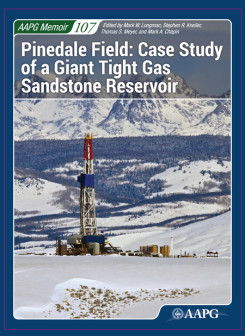Pinedale Field: Case Study of a Giant Tight Gas Sandstone Reservoir
Improved geologic insights combined with advances in technology and innovative thinking, mainly since the late 1990s, have driven Pinedale field's development and unlocked a giant natural gas resource in stacked low-permeability fluvial sandstones. Understanding this field can provide a model for developing similar tight sandstone reservoirs around the world.
This memoir contains 15 well-illustrated, peer-reviewed chapters that describe the history of field development, the deposition and diagenesis of the reservoir rocks, geophysical characteristics of the field, special core analysis techniques used to better quantify the reservoir, petrophysical characteristics and interpretations of the reservoir, the types and abundance of natural fractures, and fluid production characteristics in the field. Finally, static and dynamic models for the field are presented in an attempt to integrate all the pieces of this giant geologic puzzle.
- Genre: All Books, Sandstones
Cast & Characters
| 1-10 | The Significance of the Pinedale Field |
| 11-36 | History of Exploration and Commercialization of the Giant Pinedale Tight Gas Sand Field, Sublette County, Wyoming |
| 37-60 | The Pinedale Gas Field: A Sweet Spot in a Regionally Pervasive Basin-centered Gas Accumulation, Green River and Hoback Basins, Wyoming |
| 61-116 | Geology of the Lance Pool, Pinedale Field |
| 117-174 | Geophysical Interpretation of Pinedale Field |
| 175-246 | Sedimentology and Reservoir Characterization of the Upper Cretaceous Lance and Upper Mesaverde Intervals from Core Data in Pinedale Field, Wyoming |
| 247-272 | Sedimentology and Reservoir Characterization of the Wagon Wheel Formation from Seismic, Log, and Core Data in Pinedale Field, Wyoming |
| 273-320 | Results of Deep Drilling on the Pinedale Anticline |
| 321-350 | Development of Tight Gas Sand Core Analysis Techniques for the Pinedale Field, Sublette County, Wyoming |
| 351-416 | Petrophysics of the Lance and Upper Mesaverde Reservoirs at Pinedale Field, Sublette County, Wyoming, USA |
| 417-442 | Petrophysical Interpretation of the Northern Pinedale Field, Sublette County, Wyoming |
| 443-468 | Natural Fractures on the Pinedale Anticline as Seen in Cores and on Image Logs |
| 469-496 | Pinedale Anticline and Jonah Fields, Sublette County, Wyoming: A Geologic Discussion and Comparison |
| 497-532 | Integrated Static and Dynamic Modeling of the Pinedale Tight Gas Field, Wyoming |
| 533-547 | Fluid Production Characteristics in Pinedale and Jonah Fields |

